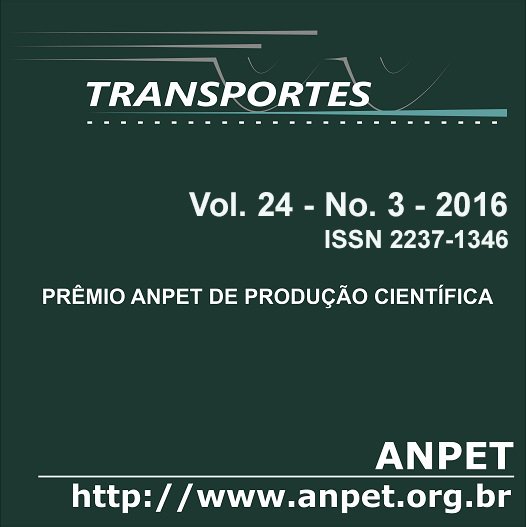Evaluating lane-by-lane gap-out based signal control for isolated intersection under stop-line, single and multiple advance detection systems
DOI:
https://doi.org/10.14295/transportes.v24i3.1142Keywords:
Actuated Signal Control, Advance Detectors, gap-out, lane-by-lane detection, FHWA, VISAbstract
In isolated intersection’s actuated signal control, inductive loop detector layout plays a crucial role in providingthe vehicle information to the signal controller. Based on vehicle actuations at the detector, the green time is extended till a pre-defined threshold gap-out occurs. The Federal Highway Administration (FHWA) proposed various guidelines for detec-tor layouts on low-speed and high-speed approaches. This paper proposes single and multiple advance detection schemes for low-speed traffic movements, that utilizes vehicle actuations from advance detectors located upstream of the stop-line, which are able to detect spill-back queues. The proposed detection schemes operate with actuated signal control based on lane-by-lane gap-out criteria. The performance of the proposed schemes is compared with FHWA’s stop-line and single advance detection schemes in the VISSIM simulation tool. Results have shown that the proposed single advance detection schemes showed improved performance in reducing travel time delay and average number of stops per vehicle under low volumes while the multiple advance detection scheme performed well under high volumes.Downloads
References
Bonneson, J. A., McCoy, P. T., e Moen, B. A. (1994) Traffic detector design and evaluation guidelines. Research Report, TRP-02-31-93, Nebraska Department of Roads, Nebraska, USA.
Bonneson, J. A., Sunkari, S., e Pratt, M. (2009) Traffic Signal Operations Handbook. Federal Highway Administration Report, FHWA/TX-09/0-5629-P1, Texas Department of Transportation, Texas, USA.
DfT (1997) The "MOVA" signal control system. Traffic advisory leaflet 3/97, Department of Transport, UK.
Hulscher, F. R. (1976) Selection of Vehicle Detectors for Traffic Management. Traffic Engineering and Control, Transport and Road Research Laboratory, UK.
Hunt, P.B., Bretherton, R. D., Robertson, D. I., e Royal, M. C. (1982) The SCOOT online traffic signal optimization technique. Traffic Engineering and Control, v. 23, p. 190-192.
ITSJPO (2014) Intelligent Transportation Systems Joint Program Office. Unit Cost Entries for Inductive Loop Surveillance on Corridor. Disponível em: <http://www.itscosts.its.dot.gov/ITS/benecost.nsf/DisplayRUCByUnitCostElementUnadjusted?ReadForm&UnitCostElement=Inductive+Loop+Surveillance+on+Corridor+&Subsystem=Roadside+Detection+(RS-D)> Acesso em: 10 de Jul. 2015.
Kay, J. L., Henry, R. D., e Smith, S. A. (1975) Locating Detectors for Advanced Traffic Control Strategies. Federal Highway Administration Report, FHWA-RD-75-91, U.S Department of Transportation, Washington, DC, USA.
Koonce, P. (2008) Traffic Signal Timing Manual. Federal Highway Administration Report, FHWA-HOP-08-024, U.S Department of Transportation, Washington, DC, USA.
Lin, F. B. (1985) Optimal Timing Settings and Detector Lengths of Presence Mode Full-Actuated Control. Transportation Research Record 1010, p. 37-45.
PTV (2012) VISSIM 5.40 User Manual. PTV Planung Transport Verkehr AG, Karlsruhe, Germany.
Sims, A. G., e Dobinson, K., W. (1980) The Sydney Coordinated Adaptive Traffic (SCAT) System Philosophy and Benefits. IEEE Transactions on Vehicular Technology, v. 29, n. 2, p. 130-137. DOI: 10.1109/T-VT.1980.23833
Smaglik, E., Bullock, D., e Urbanik, T. (2005) Evaluation of Lane-by-Lane Vehicle Detection for Actuated Controllers Serving Multilane Approaches. Transportation Research Record 1925, p. 123–133. DOI: 10.3141/1925-13
Stevanovic, A. (2010) Adaptive Traffic Control Systems: Domestic and Foreign State of Practice – A Synthesis of Highway Practice. NCHRP Synthesis 403, Transportation Research Board, National Research Council, Washington, DC.
Tian, Z. e Urbanik, T. (2006) Green Extension and Traffic Detection Schemes at Signalized Intersections. Transportation Research Record 1978, p. 16-24. DOI: 10.3141/1978-05
Wang, X. (2008) Evaluation of Lane-by-Lane Detection at Signalized Intersections Using Simulation. ITE Journal, v. 78, n.11, p. 16-21.
Zimmerman, K., e Bonneson, J. A. (2006) In-Service Evaluation of Detection-Control System for Isolated High-Speed Signalized Intersections. Transportation Research Record 1978, p. 34-41. DOI: 10.3141/1978-07
Downloads
Published
How to Cite
Issue
Section
License
Authors who submit papers for publication by TRANSPORTES agree to the following terms:
- The authors retain the copyright and grant Transportes the right of first publication of the manuscript, without any financial charge, and waive any other remuneration for its publication by ANPET.
- Upon publication by Transportes, the manuscript is automatically licensed under the Creative Commons License CC BY 4.0 license. This license permits the work to be shared with proper attribution to the authors and its original publication in this journal.
- Authors are authorized to enter into additional separate contracts for the non-exclusive distribution of the version of the manuscript published in this journal (e.g., publishing in an institutional repository or as a book chapter), with recognition of the initial publication in this journal, provided that such a contract does not imply an endorsement of the content of the manuscript or the new medium by ANPET.
- Authors are permitted and encouraged to publish and distribute their work online (e.g., in institutional repositories or on their personal websites) after the editorial process is complete. As Transportes provides open access to all published issues, authors are encouraged to use links to the DOI of their article in these cases.
- Authors guarantee that they have obtained the necessary authorization from their employers for the transfer of rights under this agreement, if these employers hold any copyright over the manuscript. Additionally, authors assume all responsibility for any copyright infringements by these employers, releasing ANPET and Transportes from any responsibility in this regard.
- Authors assume full responsibility for the content of the manuscript, including the necessary and appropriate authorizations for the disclosure of collected data and obtained results, releasing ANPET and Transportes from any responsibility in this regard.










